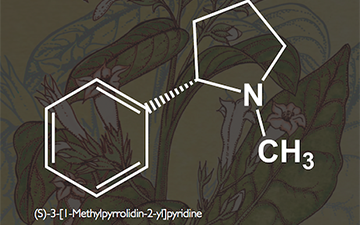Nicotine is a potent parasympathomimetic alkaloidfound in the nightshade family of plants (Solanaceae) and a stimulant drug. Nicotine is a nicotinic acetylcholine receptor (nAChR) agonist,[3][4] (a Na⁺/K⁺ ionophore through neural postsynaptic membranes in mammals and insects) except atnAChRα9 and nAChRα10 where it acts as anantagonist.[3] It is made in the roots of and accumulates in the leaves of the nightshade family of plants. Nicotine is found in the leaves of Nicotiana tabacum and Nicotiana rustica in amounts of 2–14 %, as well as in Duboisia hopwoodii andAsclepias syriaca.[5]
It constitutes approximately 0.6–3.0% of the dry weight of tobacco[6] and is present in the range of 2–7 µg/kg of various edible plants.[7] It functions as anantiherbivore chemical; consequently, nicotine was widely used as an insecticide in the past[8][9] andneonicotinoids such as imidacloprid are currently widely used.
In lesser doses (an average cigarette yields about 2 mg of absorbed nicotine), the substance acts as astimulant in mammals, while high amounts (50–100 mg) can be harmful.[10][11][12] This stimulant effect is a major contributing factor to the addictive properties of tobacco smoking.
(From Wikipedia, July 2015)


